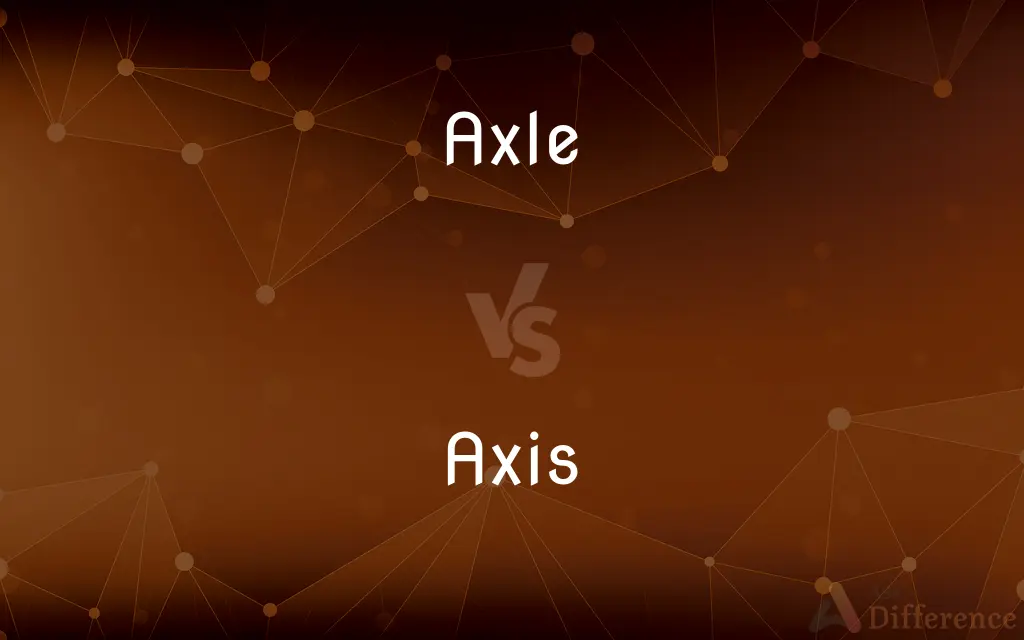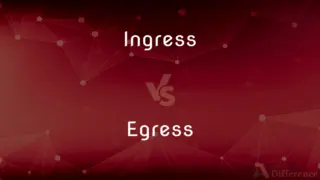Axle vs. Axis — What's the Difference?
By Tayyaba Rehman — Updated on October 4, 2023
Axle is a rod or spindle connecting or supporting rotating wheels. Axis is an imaginary line about which a body or geometric object rotates or may be conceived to rotate.

Difference Between Axle and Axis
Table of Contents
ADVERTISEMENT
Key Differences
"Axle" refers to a physical rod or spindle that either connects a pair of rotating wheels or passes through a rotating wheel, primarily in vehicles. On the contrary, "axis" may denote an imaginary line about which a body, figure, or system rotates, extending beyond vehicular contexts into mathematics, anatomy, and more.
When discussing an "axle," we emphasize a tangible, mechanical component crucial for the motion of vehicles, translating rotational force to movement. On the other hand, "axis" suggests a theoretical or intangible line, focusing on a pivotal point around which movement or symmetry is defined, with applications in various fields.
Within mechanical contexts, the "axle" becomes a central point of focus for it is physically present and plays a vital role in enabling wheel rotation. Differently, when referring to an "axis," attention may be directed towards the pattern or manner of rotation or symmetry about that imagined line, which may not physically exist.
In practical applications, "axle" inherently speaks to the concept of motion, rotational force, and physical mechanics, and is typically confined to these areas. Alternatively, "axis" transcends such limits, often surfacing in mathematical graphs, astronomical observations, or discussing symmetry and rotation in general settings.
Etymologically, “axle” is rooted in mechanical contexts, and its meanings rarely deviate. In contrast, “axis” carries meanings that branch into astronomy, mathematics, geography, and more, hinting at an inherent conceptual flexibility and wide applicability in language.
ADVERTISEMENT
Comparison Chart
Physicality
Physical rod or spindle
Imaginary or conceptual line
Application
Predominantly mechanical/vehicular
Varied: math, astronomy, anatomy, etc.
Relation to Motion
Directly facilitates motion
Describes/defines rotation or symmetry
Tangibility
Always tangible
May not be tangible
Context
Limited, mostly related to vehicles
Broad and applicable in various contexts
Compare with Definitions
Axle
A pin or spindle on which a wheel revolves.
The wheel spins smoothly on the axle.
Axis
A reference line for the measurement of coordinates.
The graph is divided into the x-axis and y-axis.
Axle
A rod connecting and supporting rotating wheels.
The broken axle caused the car to halt.
Axis
A principal structure of an organism.
The spinal axis supports bipedal posture.
Axle
A fixed bar or beam connected to moving locomotive parts.
Ensure the axle is lubricated to avoid rusting.
Axis
An alliance of multiple parties or countries.
The Axis powers were prominent during World War II.
Axle
An axle or axletree is a central shaft for a rotating wheel or gear. On wheeled vehicles, the axle may be fixed to the wheels, rotating with them, or fixed to the vehicle, with the wheels rotating around the axle.
Axis
A straight line about which a body or geometric object rotates or may be conceived to rotate.
Axle
A supporting shaft or member on or with which a wheel or a set of wheels revolves.
Axis
An unlimited line, half-line, or line segment serving to orient a space or a geometric object, especially a line about which the object is symmetric.
Axle
The spindle of an axletree.
Axis
A reference line from which distances or angles are measured in a coordinate system.
Axle
Either end of an axletree.
Axis
A center line to which parts of a structure or body may be referred.
Axle
(obsolete) Shoulder.
Axis
An imaginary line to which elements of a work of art, such as a picture, are referred for measurement or symmetry.
Axle
The pin or spindle on which a wheel revolves, or which revolves with a wheel.
Axis
The second cervical vertebra on which the head turns.
Axle
A transverse bar or shaft connecting the opposite wheels of a car or carriage; an axletree.
Axis
Any of various central structures, such as the spinal column, or standard abstract lines used as a positional referent.
Axle
An axis.
The Sun's axle
Axis
(Botany) The main stem or central part about which organs or plant parts such as branches are arranged.
Axle
The pin or spindle on which a wheel revolves, or which revolves with a wheel.
Axis
One of three mutually perpendicular lines that define the orientation of an aircraft, with one being along its direction of travel and the other two being perpendicular to the direction of travel.
Axle
A transverse bar or shaft connecting the opposite wheels of a car or carriage; an axletree.
Axis
A line through the optical center of a lens that is perpendicular to both its surfaces.
Axle
An axis; as, the sun's axle.
Had from her axle tornThe steadfast earth.
Axis
One of three or four imaginary lines used to define the faces of a crystal and the position of its atoms.
Axle
A shaft on which a wheel rotates
Axis
An alliance of powers, such as nations, to promote mutual interests and policies.
Axle
A bar on which a particular object or structure rotates.
The hamster wheel’s axle allows it to turn.
Axis
Axis The alliance of Germany and Italy in 1936, later including Japan and other nations, that opposed the Allies in World War II.
Axle
The supporting shaft to rotary items in machinery.
The machine malfunctioned due to a bent axle.
Axis
(geometry) An imaginary line around which an object spins (an axis of rotation) or is symmetrically arranged (an axis of symmetry).
The Earth rotates once a day on its axis
Axis
(mathematics) A fixed one-dimensional figure, such as a line or arc, with an origin and orientation and such that its points are in one-to-one correspondence with a set of numbers; an axis forms part of the basis of a space or is used to position and locate data in a graph (a coordinate axis)
Axis
(skeleton) The second cervical vertebra of the spine
Axis
(anatomy) An imaginary, visualized plane separating two morphologically similar parts of an organism
Axis
(psychiatry) A form of classification and descriptions of mental disorders or disabilities used in manuals such as the DSM (Diagnostic and Statistical Manual of Mental Disorders)
Axis
(botany) The main stem or central part about which organs or plant parts such as branches are arranged
Axis
(military) An alliance or coalition.
Axis
A deer native to Asia, of species Axis axis.
Axis
The spotted deer (Cervus axis or Axis maculata) of India, where it is called hog deer and parrah (Moorish name).
Axis
A straight line, real or imaginary, passing through a body, on which it revolves, or may be supposed to revolve; a line passing through a body or system around which the parts are symmetrically arranged.
Axis
A straight line with respect to which the different parts of a magnitude are symmetrically arranged; as, the axis of a cylinder, i. e., the axis of a cone, that is, the straight line joining the vertex and the center of the base; the axis of a circle, any straight line passing through the center.
Axis
The stem; the central part, or longitudinal support, on which organs or parts are arranged; the central line of any body.
Axis
The second vertebra of the neck, or vertebra dentata.
Axis
One of several imaginary lines, assumed in describing the position of the planes by which a crystal is bounded.
Axis
The primary or secondary central line of any design.
Axis
A straight line through a body or figure that satisfies certain conditions
Axis
The center around which something rotates
Axis
The main stem or central part about which plant organs or plant parts such as branches are arranged
Axis
In World War II the alliance of Germany and Italy in 1936 which later included Japan and other nations;
The Axis opposed the Allies in World War II
Axis
A group of countries in special alliance
Axis
The 2nd cervical vertebra; serves as a pivot for turning the head
Axis
An imaginary line about which an object rotates.
The Earth rotates on its axis.
Axis
A straight central part in a structure to which other parts are connected.
The axis of the umbrella provides stability.
Common Curiosities
Can "axis" refer to an imaginary line?
Yes, "axis" often denotes an imaginary or conceptual line around which something rotates.
Is "axle" essential for wheel rotation in vehicles?
Absolutely, "axle" is critical for connecting and supporting rotating wheels in vehicles.
Can "axis" describe patterns or symmetry in mathematics?
Yes, "axis" can describe a point of symmetry or a reference line in mathematical contexts.
Can "axis" be used in anatomical contexts?
Yes, "axis" can describe a central structural line in anatomy, such as the spinal axis.
Is "axis" used in astronomical contexts?
Yes, "axis" is used to describe the imaginary line about which celestial bodies rotate.
Can "axle" refer to any rotating machinery part?
Typically, yes. "Axle" generally refers to shafts or rods on which something rotates in various machinery.
Is "axis" pluralized as "axes" [aks-eez]?
Yes, "axes" is the correct plural form of "axis."
Is "axle" always a tangible component?
Yes, "axle" refers to a physical rod or spindle facilitating rotation in machinery.
Can "axle" and "axis" be used interchangeably in mechanics?
No, "axle" refers to a physical component, while "axis" often refers to an imaginary rotational line.
Does "axle" primarily relate to mechanical contexts?
Yes, "axle" generally pertains to mechanical and vehicular contexts.
Is "axle" related to the function of gears?
Yes, axles may connect gears and facilitate their rotation in machinery.
Is "axle" used in non-mechanical contexts?
Rarely, "axle" is most commonly used in mechanical and vehicular contexts.
Can an "axle" exist independently of a wheel?
Yes, but axles are primarily associated with facilitating wheel rotation.
Can "axis" refer to a political alliance?
Yes, "axis" can denote a political alliance, like the Axis powers in WWII.
Can "axis" define rotational motion in physics?
Yes, "axis" can describe the line about which rotational motion occurs in physics.
Share Your Discovery

Previous Comparison
Honourable vs. Honorable
Next Comparison
Ingress vs. EgressAuthor Spotlight
Written by
Tayyaba RehmanTayyaba Rehman is a distinguished writer, currently serving as a primary contributor to askdifference.com. As a researcher in semantics and etymology, Tayyaba's passion for the complexity of languages and their distinctions has found a perfect home on the platform. Tayyaba delves into the intricacies of language, distinguishing between commonly confused words and phrases, thereby providing clarity for readers worldwide.
















































